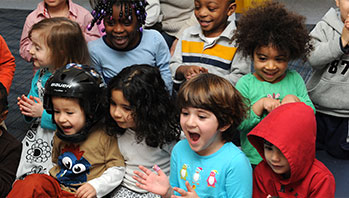- name cards
MA Standards:
Speaking and Listening/
SL.PK.MA.1a: Observe and use appropriate ways of interacting in a group (e.g., taking turns in talking, listening to peers, waiting to speak until another person is finished talking, asking questions and waiting for an answer, gaining the floor in appropriate ways).
Foundational Skills/RF.PK.MA.3.c: Recognize one’s own name and familiar common signs and labels (e.g., STOP).
Head Start Outcomes:
Social Emotional Development/Self-Regulation: Follows simple rules, routines, and directions.
Language Development/Receptive Language: Attends to language during conversations, songs, stories, or other learning experiences.
PreK Learning Guidelines:
English Language Arts/Language 1: Observe and use appropriate ways of interacting in a group (taking turns in talking; listening to peers; waiting until someone is finished; asking questions and waiting for an answer; gaining the floor in appropriate ways).
English Language Arts/Reading and Literature 12: Listen to, recite, sing, and dramatize a variety of age-appropriate literature.
Greeting Song: “If Your Name Is in My Hand” #2

© Commonwealth of Massachusetts, Department of Early Education and Care (Jennifer Waddell photographer). All rights reserved.
ELA Focus Skills: Name Recognition, Speaking and Listening
Sing “If Your Name Is in My Hand.” Hold up two different names for each of the first two lines. Keep both cards in your hands so you can hold them both up when you sing the last line.
- Remind each child to say “I’m here!” when you hold up his or her card.
- Have children reply in unison for the last line, “We’re here!”
- Continue until each child has been called.
If Your Name Is in My Hand
(sung to the tune of “If You’re Happy and You Know It”)
If your name is in my hand, say, “I’m here!” (I’m here!)
If your name is in my hand, say, “I’m here!” (I’m here!)
If your name is in my hand, then you really ought to stand. (stand)
If your name is in my hand, say, “I’m here!/We're here!” (I’m here!/We're here!)
Adaptation: For groups with children of varying ages, if you covered singular/plural at the beginning of the week, review the concept. Show pictures of single items and pictures with several of the same items. Have children describe each picture, for example: cat/cats; flower/flowers.
